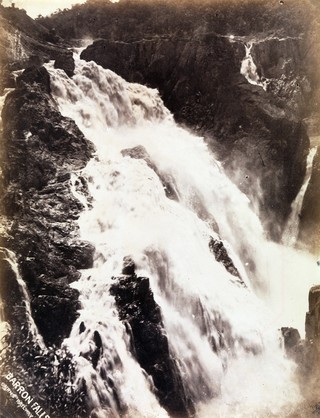Barron Falls — reflecting on the forces of nature

Winifred Rumney, England/Australia 1870–1946 / Barron Falls 1906 / Oil on canvas / 128.9 x 86.2cm / Gift of the Agent-General for Queensland, London 1971 / Collection: Queensland Art Gallery | Gallery of Modern Art / View full image
Winifred Rumney’s Barron Falls 1906 is a powerful painting capturing the raging waters in minute detail after substantial rainfall, the artist acknowledging the power of the forces of nature. The Falls became one of the most popular tourist attractions in Queensland after the Kuranda Scenic Railway opened in 1891, allowing visitors to access its natural features.
Rumney (1870-1946) painted Barron Falls located in Far North Queensland in the early part of the twentieth century, it is a unique work painted in Edwardian Queensland at a time when most women artists were painting flower pieces. It is even more unusual because this large landscape was executed by a little known artist who taught at a Technical College in Cairns.
Barron Falls 1906

Winifred Rumney, England/Australia 1870–1946 / Barron Falls 1906 / Oil on canvas / 128.9 x 86.2cm / Gift of the Agent-General for Queensland, London 1971 / Collection: Queensland Art Gallery | Gallery of Modern Art / View full image
Barron Falls documented in the early twentieth century
Barron Gorge National Park is a World Heritage Area north-west of Cairns and part of the traditional lands of the Djabugandji Bama people who maintain a close spiritual connection with Country. The steep tiered cascade waterfall tumbling over craggy rocks on the Barron River is located where the water descends from the elevated regions of the Atherton Tablelands to the Cairns coastal lowlands.

Barron Falls, Cairns railway c.1895 / Gelatin silver photograph on paper / 22.9 x 17.6cm (irreg.) / Purchased 2005.The Queensland Government's special Centenary Fund / Collection: Queensland Art Gallery | Gallery of Modern Art / View full image

Harriett Pettifore Brims 1864-1939 / Barron Falls c.1900 from a now disused viewing point along the walking path to the bottom of the falls / 31054-0001-0129 / Courtesy: John Oxley Library, State Library of Queensland, Brisbane / View full image

Harriett Pettifore Brims 1864-1939 / Viewing platform at Barron Falls / 31054-0001-0230 / Courtesy: John Oxley Library, State Library of Queensland, Brisbane / View full image

Barron Falls (from Station), Cairns Railway, Queensland (from ‘Coloured Shell Series’) c.1910 / Postcard: Colour lithograph on paper / 9 x 13.7cm / 116477 / Courtesy: John Oxley Library, State Library of Queensland, Brisbane / View full image
Kuranda Scenic Railway
The Falls can be viewed from the Historic Scenic Railway which cuts through the National Park on its journey between Cairns to Kuranda, just 27km away and at an altitude of 330m. Construction of the railway began in 1886, when completed in 1891 the Falls became one of the most popular tourist attractions in Queensland, with visitors able to access its natural features and scenery.
Barron Falls and Cairns Railway c.1910

Barron Falls and train, Cairns Railway, Queensland (from ‘Coloured Shell Series’) c.1910 / Postcard: Colour lithograph on paper / 9 x 13.7cm / Gift of Glenn R Cooke through the QAGOMA Foundation 2014 / Collection: Queensland Art Gallery | Gallery of Modern Art / View full image

Barron Falls Station, Cairns Railway, Queensland (from ‘Coloured Shell Series’) c.1910 / Postcard: Colour lithograph on paper / 9 x 13.7cm / 1319089 / Courtesy: John Oxley Library, State Library of Queensland, Brisbane / View full image
Winifred May Rumney
Winifred Rumney (nee Quinnell), the daughter of Elvina Robinson and Colonel R.J. Quinnell, according to her own story, My career as an artist by Winifred Rumney, both she and her brother Cecil, a founder of London’s Royal Society of Miniature Artists, showed artistic promise from an early age. She studied freehand and model drawing at the College of Preceptors in London from 1884 to 1886, before attending the South Kensington School of Art from 1886 to 1887.
After arriving in Australia in 1889, she taught at the Sandgate Ladies’ College from 1890 to 1892. Sandgate, located below the Redcliffe peninsula, was a popular seaside destination for Brisbane’s early settlers in the late 1800s.
From 1853, Rumney travelled to Victoria and painted botanical scenes at the Royal Botanic Gardens in Melbourne for both Baron Ferdinand von Mueller (1825-96), the Victorian Government Botanist, and for a time Director of the Gardens; and William Robert Guilfoyle (1840-1912), landscape gardener and botanist, acknowledged as the architect of the Melbourne Gardens.
Traveling to Tasmania, Rumney took lessons in ‘sky and foliage’ from Gladstone Eyre (1862-1933), an Australian portrait artist and landscape painter. In 1896 she married Thomas Rumney in Launceston.
By 1900 Rumney had returned to Queensland, living first in Rockhampton and then in Cairns where she taught painting at Cairns Technical College. While in Cairns, Rumney gave private painting classes and sold her canvases, depicting Far North Queensland scenes.
In 1915, she returning to Melbourne after her husband died where she continued to teach.
Barron Falls today

Barron Falls today / 228169 / Courtesy: John Oxley Library, State Library of Queensland, Brisbane / View full image
Curatorial extracts, research and supplementary material compiled by Elliott Murray, Senior Digital Marketing Officer, QAGOMA

